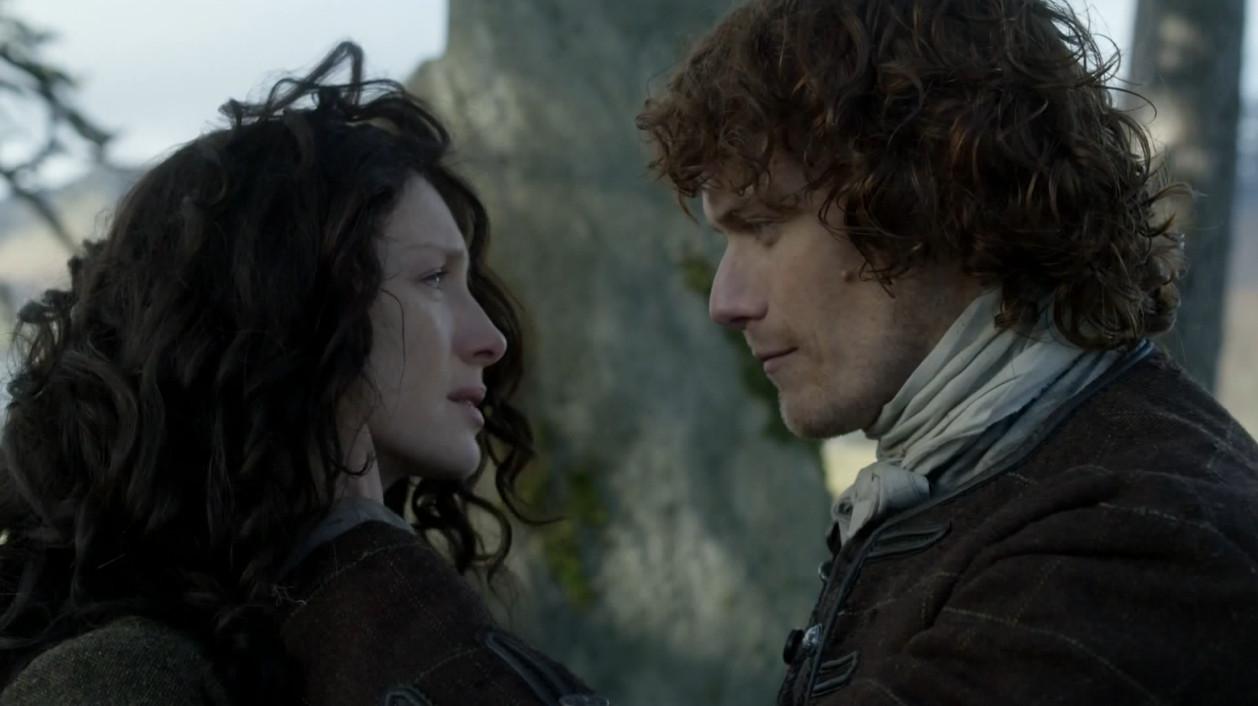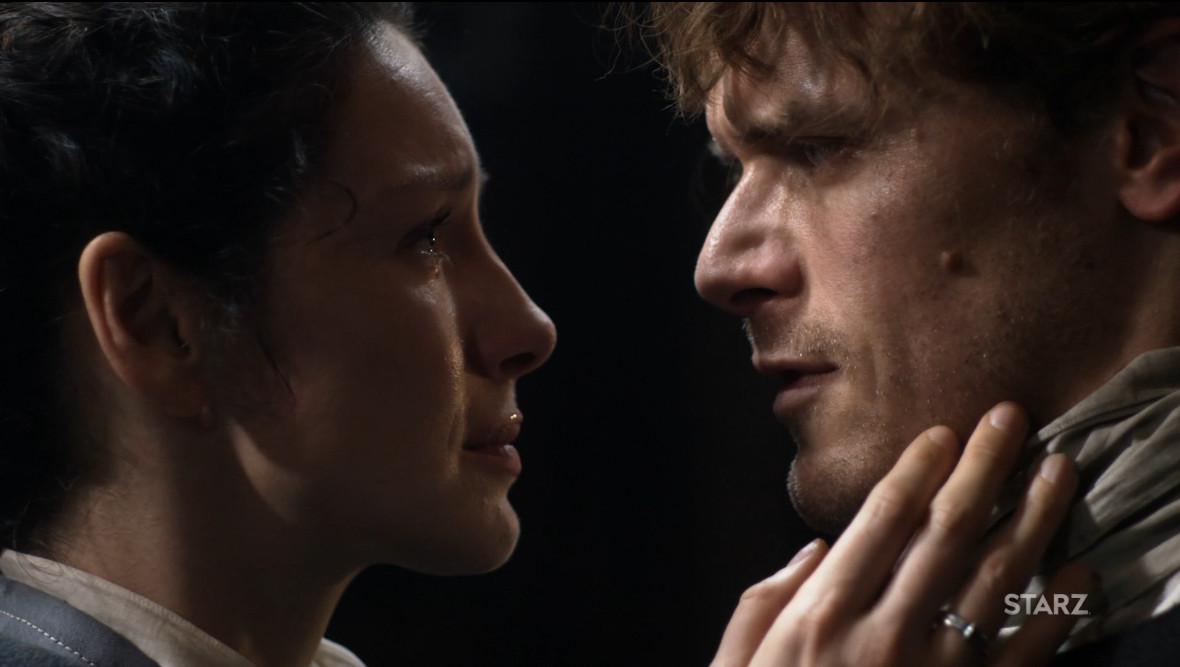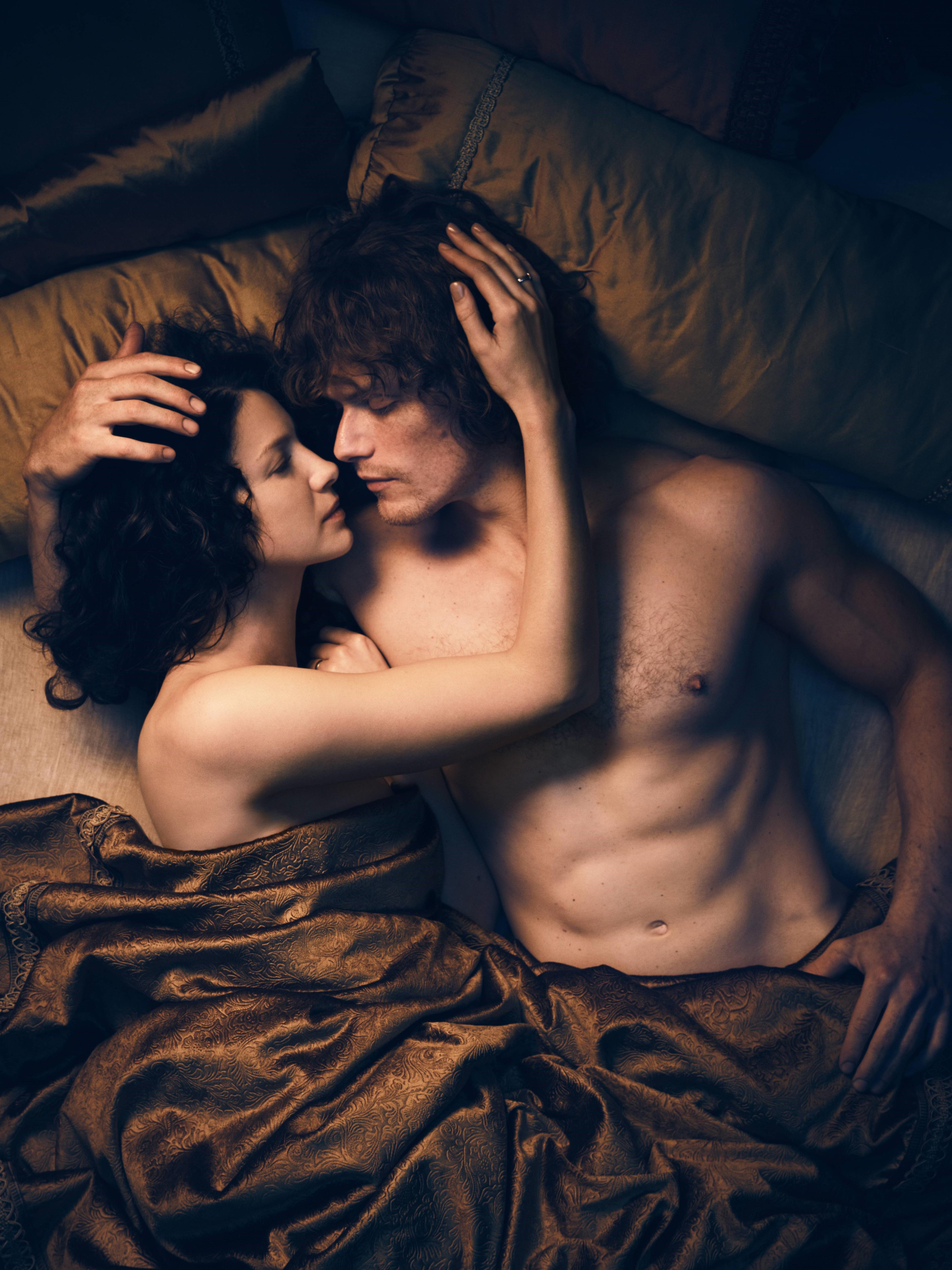
There’s always been plenty to envy about Claire and Jamie, the star-crossed couple whose centuries-spanning romance propels the period drama Outlander. They’re capable, brave, and beautiful, blessed by an unbreakable bond, strong convictions, and even stronger sex drives. Since the series’ first season, their ear-pleasing accents, smoldering, soul-searching looks, telegenic love-making, and repeated rescues of each other’s lives have set a high standard, relationship-wise. But recent episodes of Outlander have introduced us to yet another quality we wish we had in common with Claire and Jamie: They’re almost immune to aging.
By their third seasons, many TV series settle into a rut—a familiar and welcome one, in the case of some comfort TV, but less so for hour-long dramas with fantasy elements, which traffic in twists and upheaval. But disrupting the status quo wasn’t a struggle for Outlander, an adaptation of Diana Gabaldon’s book series, which comprises eight novels (with a ninth on the way) and assorted shorter works. Through 37 episodes, the Starz series’ story is still closer to takeoff than landing, working through the third book in the sequence, 1993’s Voyager.
The events of Voyager dictated an unorthodox interlude for a program that’s centered on the interplay (and intercourse) between two charismatic and chemistry-laden leads: an extended separation and a mutual 20-year time jump. At the end of Season 2, the pregnant Claire (a 20th-century English nurse who in the first season accidentally slips into the past through, um, a mystical stone) and Jamie (her 18th-century, red-haired highlander lover) are forced to break up by the impending Battle of Culloden, at which Jamie, a Jacobite rebel, expects to be (and nearly is) killed.
To protect their soon-to-be-born daughter Brianna, Claire (played by Caitriona Balfe) returns to the 1940s. Believing that Jamie (played by Sam Heughan) did die, she does her best to move on, relocating to Boston, raising Brianna, becoming a doctor, and growing apart from her first husband, Frank, who’s caring and attentive but lacks Jamie’s highland lilt, kilt collection, and Men’s Health cover physique. Jamie, meanwhile, survives battle, torture, and imprisonment (nothing new for him), grows and shaves a big beard, fathers a son, pivots to printing and smuggling, and gets married again out of loneliness, all while carrying an eternal torch for Claire. Midway through the third season, after almost five episodes apart, they reunite in the mid-1760s, two decades older but no less in love—and, curiously, looking a lot like they did the last time they were together.
“I wanted to look—well, the same as when you last saw me,” Claire says with some trepidation during their first conversation, admitting that she’s dyed away the single gray streak that had appeared in her hair in earlier, Boston-centric scenes. Mission accomplished, Claire. Neither member of Outlander’s leading duo looks any worse for wear after 20 years of imprisonment, parenthood, and pining for lost love.


For Outlander’s creators, the time jump presented a production dilemma, not because of the story (which Gabaldon had already plotted out) or setting (most viewers aren’t well-versed in the intricacies of 1740s vs. 1760s style), but because of the actors’ appearances. In real life, a two-decade difference isn’t invisible, no matter how much St. Ives Oatmeal and Shea Butter Lotion you lather on because of Balfe.
Heughan, 37, and Balfe, 38, were both 34 when the series premiere aired in 2014, but their characters were considerably younger. “Jamie’s kind of early 20s, Claire is late 20s when it starts,” Outlander executive producer Maril Davis says by phone. Three years passed between Claire’s first time jump back to 1743 and the Battle of Culloden, which, Davis says, would put both of them in their “mid- to later-40s after the [20-year] time jump.” Although the creators talked about shortening the story’s time jump to reduce the need to alter the actors’ appearance, they found that they couldn’t do it without omitting too many plot points from the characters’ time apart.
Aware that the time jump was looming, the producers started doing screen tests last season with Balfe and Heughan, in consultation with head of hair and makeup Annie McEwan, who had worked on Season 4 of Game of Thrones before joining the Outlander crew. After experimenting with various looks, the creative team decided, essentially, that both Balfe and Heughan were too hot to convincingly tamper with by obscuring their actual features. “We have two actors who happen to be incredibly beautiful people,” Davis says. “It is hard to make them look bad, damn them.” Originally, the pair’s first post-reunion sex scene featured a reference to stretch marks, but the writers lost that line from the script, Davis says, when the makeup crew informed them that stretch marks “don't read very well on camera.”
Even apart from the specific challenge of wrinkling, graying, and thickening two age-resistant actors, the transition from 20s to 40s is a particularly tough one. “It's hard to make young people look incrementally older,” Davis says. “It's obviously a little easier—and I put ‘easier’ in quotes—if you're aging someone up from like 30 to 80. … With two actors who look so young anyways in their real life, we realized that we couldn't do major jumps without it looking fake, and also taking a lot of extra time in hair and makeup, as well as using a lot of extra prosthetics.”
For Davis, a veteran of more explicitly sci-fi (and more makeup- and prosthetic-reliant) productions such as Star Trek and Battlestar Galactica, Outlander’s understated approach to the aging process didn’t come intuitively. “There were some times that I said to our hair and makeup team, ‘Can we go farther? Because you can't read some of these lines that you're painting on camera,’” Davis says. “And they were horrified. They were like, ‘Are you kidding? Oh my god, we can't go any farther.’ It's interesting, because you also have to take the advice of people that have been in the business doing the hair and makeup a long time, knowing that they can only go so far until they feel uncomfortable because it doesn't look real anymore.”
In addition to the aging uncanny valley, there’s the time cost to the talent and crew to consider. A heavier hand on the cosmetic side—on top of the prosthetic flogging scars already applied to Heughan’s back in shirtless scenes for much of the series’ run—would mean much more time in makeup chairs, staring blankly into mirrors as fake years and real hours add up. Though according to Davis, Balfe and Heughan, who were frequently consulted, never expressed any reservations about hiding their youth under veneers of age. “They're both very game for whatever we want to do, and so this isn't a vanity thing,” she says. “Neither of them, I don't think, at any point has ever said, ‘I have to look good, so don't make me look too old.’”
This was a weighty decision, because the ramifications for the series could extend far into the future. Unlike some shows or movies that might insert a brief flash-forward in a single scene or episode, Outlander is committed to the time jump for the long term. Whatever aging the crew applied to Balfe and Heughan now would sentence them to the same look for years to come on a series that may still be relatively early in its run (which already has been renewed for a fourth season). That’s not only a nuisance, but potentially an acting inhibitor, as Davis says Heughan discovered while wearing his wild beard in the third season’s second episode. “If you have something on your face like that, sometimes it's a little harder to talk, you're more aware of it, it takes you out,” Davis says. “So all of these things are factors, and same with if we were getting into heavy prosthetics to make actors appear much older than they are.”
The end result of all the discussion and screen tests is a difference so subtle that you have to squint to see it—just like the new, older Jamie has to squint to see small text without wearing his reading glasses. Specs aside, he looks almost unchanged. “With Sam, we've kind of weathered him, adding more shading to his face,” Davis says. “We've got some lines that the hair and makeup department have put in themselves, and then greying at the temples for him, as well as with Caitriona. We realized because her skin is also so young that we'd have to sell a lot of it with the gray in her hair.” Of course, even that gray is gone now, at least temporarily, although Davis says its absence stems from an impulse to portray Claire’s humanizing insecurity, rather than a need to preserve the stars’ romance-novel looks (which she acknowledges are part of the show’s appeal). “So much of our talk about appearance is motivated from a character standpoint,” she says. “I don't think we ever go, ‘Oh my god, they have to look amazing because this show is trying to sell a fantasy element.’” But who’s to say that the mystical stones don’t have anti-aging effects?
In navigating the time jump, the producers’ overriding desire was to avoid distracting the audience by going overboard on aging. “You don't want to be taken out of the moment, sitting back watching at home,” Davis says. At times, though, the lack of aging is its own sort of distraction. My wife and I giggled through one supposed-to-be-tender scene as the script tried to sell us on these nearly identical-looking 30-something specimens as people pushing 50. “I don’t look like an old man?” Jamie asks self-consciously, shortly before exposing his still-chiseled chest. And Claire, after completely disrobing to reveal her youthful frame, tells an admiring Jamie, "You must really be losing your eyesight." Nobody’s buying it, guys.
The aging-related dialogue is less jarring when it alludes to the absurdity of the situation, as when Claire marvels to Jamie, “Most men in their 40s have started to go soft around the middle. You haven't a spare ounce on you,” or when she greets the family lawyer by exclaiming, “You look exactly the same!” (No Battlestar fat suits here.) In other scenes, though, the actors convincingly convey the passage of time through emotion, even though they both remain outwardly radiant. “We had so many discussions with Caitriona and Sam about this internal aging, because some of it, you are trying to sell this gravitas of 20 years of loss through their acting, which I think they do so well,” Davis says.

The best asset Outlander has in hand-waving its characters’ immutability is an audience that’s willing to suspend disbelief. “Let's be honest, we could've kept these two apart for a week and it would've seemed like an eternity,” Davis says. “I think for the fans it probably seemed like 100 years—for us as well. So I don't think we needed to add to that at all.” And if—like a lot of the Outlander faithful—you’re the sentimental type who doesn’t mind some soapiness, you’ll accept that love can conquer crow’s feet. “I think in a weird way, that 20 years just kind of faded away when they saw each other again,” Davis says. “In some ways, it was like so much time had passed, and in other ways it was like no time had passed at all because that love had never died.”
With the reunion episode’s semi-awkward aging exchanges behind it, Outlander soon stops dwelling on appearances: The following week, Jamie fireman’s carries a man from a burning building, and the week after that, not-so-newlyweds Claire and Jamie tear off their clothes and writhe around on the floor. Most Outlander watchers wouldn’t have it any other way.
Judging by the books (spoilers!), there’s still a chance that we’ll see an actually old-looking Claire and Jamie in future seasons. “If we're lucky enough to do all the books, they're in their 60s in the current books,” Davis says. “So we do want to also have somewhere to go, and we do need to use, as a base, our two actors, who are very young, and so we want to be with them on this journey.”
But based on this season, don’t be surprised if the 60-something couple doesn’t look a day over 45. “Time doesn’t matter, Sassenach,” Jamie says in Season 3’s sixth episode, using his pet name for Claire. “You will always be beautiful to me.” And also, most likely, to everyone watching at home.
